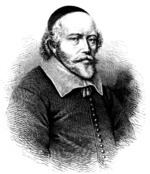Name Louis Geer Children Louis De Geer | Role Merchant | |
 | ||
Died June 19, 1652, Amsterdam, Netherlands | ||
Louis De Geer (17 November 1587, in Liège – 19 June 1652, in Amsterdam) was a Dutch merchant and industrialist of Walloon origin. He is considered the father of Swedish industry for introducing Walloon blast furnaces in Sweden. He produced cannons for the German Protestant movement, the Dutch navy and the Dutch East India Company and the Dutch West India Company.
Biography
De Geer was the son of the iron industrialist and merchant Louis de Geer de Gaillarmont (1535-1602), and Jeanne de Neille (1557-1641). His father had previously (1563) been married with Maria de Jalhéa (died 1578). In 1592, one of De Geer's half-sisters, Marie de Geer (1574-1609) married Elias Trip (1569-1636), a Dutch merchant and a director of the Dutch East India Company who lived in Dordrecht. Presumably due to ongoing turmoil in the Prince-Bishopric of Liège as well as his conversion to Protestantism, De Geer's father sold his properties in Liège in 1595 and followed his daughter to Dordrecht, where since 1589 a neighborhood had existed populated by merchants from Liège. In 1603, his daughter Margaretha de Geer (1583–1672) married Jacob Trip (1575–1661), brother and partner of Elias, further cementing the merchant families' relationship.
Johannes Polyander appears to have been an important teacher of Louis Jr. in Dordrecht. From 1605 to 1608, De Geer trained as coppersmith in Roanne in France, after which he started his first business in La Rochelle. Returning to Dordrecht in 1611 he associated himself with his brothers-in-law. In 1612, he married Adrienne Gérard (ca 1590–1634), also originally from Liège, with whom he had 16 children. Having earned a fortune as a banker and industrialist he moved his family to Amsterdam in 1615. Owing to his extensive travels he received a good education in business.
With the outbreak of the Thirty Years' War the demand for weapons increased enormously. In 1618, De Geer delivered weapons to Gustavus Adolphus of Sweden, the Swedish king. Impressed by his business instincts the Swedish government allowed him to lease estates near Finspång, Östergötland in eastern Sweden proper. Before long, De Geer had established a formidable workshop industry there. In 1623 he was active in a Swedish trading company.
The Swedish government continued to support him and De Geer received the monopoly on the copper and iron trade. De Geer, who adopted Sweden as his second home country, immigrated to Sweden in 1627. He hoped to evade paying toll in de Sont. In 1634, he bought "Het Huis met de Hoofden" on the Keizersgracht in Amsterdam. His wife died after the birth of their sixteenth child.
In 1640, De Geer travelled again to Sweden and was ennobled. In his new status he was able to buy 3/4 of the leased farmlands. As of 2011 his estate in Stockholm houses the Dutch embassy in Sweden.
Working for Axel Oxenstierna he went to Amsterdam to support the war against Denmark. In 1644, at the start of the Torstenson War against Denmark, he singlehandedly equipped an armada of ships to sail against Denmark. This fleet contained a complete marine, 32 ships with sailors, weaponry and officers. The Swedes were able to conquer Fehmarn in Denmark, thanks to his aid. De Geer is also considered responsible for the Swedish Africa Company. When he founded the company a riot started in Amsterdam in 1649. His family also provided shelter to pacifist and humanist Comenius in his home in Amsterdam. He died in 1652 after falling ill during another voyage to Sweden. He returned to Amsterdam and died there. He was buried in the family grave in the Augustijnenkerk in Dordrecht.
